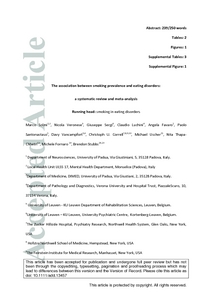Solmi, M;
Veronese, N;
Sergi, G;
Luchini, C;
Favaro, A;
Santonastaso, P;
Vancampfort, D;
Correll, CU;
Ussher, M;
Thapa-Chhetri, N;
et al.
Solmi, M; Veronese, N; Sergi, G; Luchini, C; Favaro, A; Santonastaso, P; Vancampfort, D; Correll, CU; Ussher, M; Thapa-Chhetri, N; Fornaro, M; Stubbs, B
(2016)
The association between smoking prevalence and eating disorders: a systematic review and meta-analysis.
Addiction, 111 (11).
pp. 1914-1922.
ISSN 1360-0443
https://doi.org/10.1111/add.13457
SGUL Authors: Ussher, Michael Henry
![[img]](https://openaccess.sgul.ac.uk/108017/2.hassmallThumbnailVersion/add13457.pdf)  Preview |
|
PDF
Accepted Version
Available under License ["licenses_description_publisher" not defined].
Download (779kB)
| Preview
|
Abstract
BACKGROUND AND AIMS: Cigarette smoking is associated with severe mental illness including schizophrenia and bipolar disorder, and with morbidity and mortality, but the association withanorexia (AN), bulimia nervosa (BN) and Binge Eating Disorder (BED), is unclear. This meta-analysis compared the odds of smoking in Eating Disorders (ED) (ED = AN or BN or BED) versus healthy controls (HC) and calculated the prevalence of smokers in people with ED. METHODS: Three independent authors searched PubMed,MEDLINE and Scopus from database inceptionuntil 12/31/2015 for studies reporting data on life-time or current smoking prevalence in BED, BN, and AN, with or without control group. Meta-analyses were undertaken, calculating odds ratios (ORs) of life-time smoking in BED, BN, AN vs HCs, or prevalence of smoking in BED, BN, AN with 95% confidence intervals (CI). RESULTS: Thirty-one studies (ED = 8,517, controls = 68,335) were meta-analyzed. Compared with HCs, there were significantly more smokers among people with BN (life-time OR = 2.165) and BED (life-time OR = 1.792) but not AN (life-time OR = 0.927). BED was associated with smoking the most (life-time prevalence = 47.7%) followed by BN (life-time prevalence = 39.4%) and AN (life-time prevalence = 30.8%). In BN, life-time smoking prevalence was highest in Europe. In AN, higher age moderated both life-time and current smoking prevalence, and body mass index moderated higher life-time smoking prevalence. In BN, female sex moderated higher life-time smoking prevalence. CONCLUSIONS: People with binge eating disorder and bulimia nervosa are significantly more likely to be life-time smokers than healthy controls, which is not the case for anorexia nervosa.
| Item Type: |
Article
|
| Additional Information: |
This is the peer reviewed version of the following article: Solmi, M., Veronese, N., Sergi, G., Luchini, C., Favaro, A., Santonastaso, P., Vancampfort, D., Correll, C. U., Ussher, M., Thapa-Chhetri, N., Fornaro, M., and Stubbs, B. (2016) The association between smoking prevalence and eating disorders: a systematic review and meta-analysis. Addiction, 111: 1914–1922, which has been published in final form at doi: 10.1111/add.13457.. This article may be used for non-commercial purposes in accordance with Wiley Terms and Conditions for Self-Archiving |
| Keywords: |
Anorexia nervosa, Binge eating disorder, Bulimia nervosa, Eating disorders, Meta-analysis, Moderators, Smoking, Anorexia nervosa, Binge eating disorder, Bulimia nervosa, Eating disorders, Meta-analysis, Moderators, Smoking, Substance Abuse, 11 Medical And Health Sciences, 17 Psychology And Cognitive Sciences |
| SGUL Research Institute / Research Centre: |
Academic Structure > Population Health Research Institute (INPH) |
| Journal or Publication Title: |
Addiction |
| ISSN: |
1360-0443 |
| Language: |
ENG |
| Dates: |
| Date | Event |
|---|
| 20 May 2016 | Published Online | | 18 May 2016 | Accepted | | 9 October 2016 | Published |
|
| Publisher License: |
Publisher's own licence |
| PubMed ID: |
27206671 |
 |
Go to PubMed abstract |
| URI: |
https://openaccess.sgul.ac.uk/id/eprint/108017 |
| Publisher's version: |
https://doi.org/10.1111/add.13457 |
Statistics
Item downloaded times since 20 Jul 2016.
Actions (login required)
 |
Edit Item |



